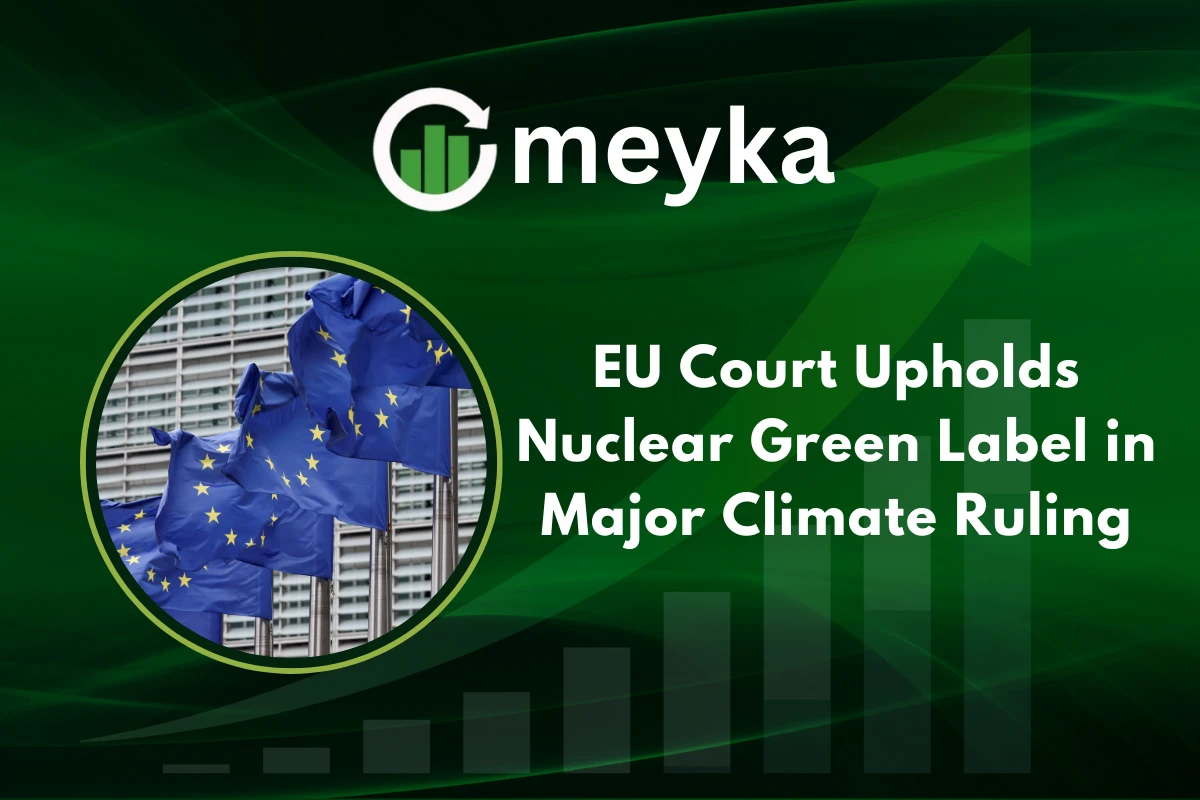EU Court Upholds Nuclear Green Label in Major Climate Ruling
In a major decision, the EU’s top court has upheld the Nuclear Green Label, ruling that nuclear energy can remain part of the European Union’s sustainable finance taxonomy under strict conditions. The judgment settles a high profile legal challenge and signals that regulators and investors will have clearer legal footing when classifying nuclear projects as sustainable.
Why does this matter for climate policy and markets? Because the ruling affects how trillions of euros in investment can be directed toward low carbon infrastructure across Europe.
What is the Nuclear Green Label?
The Nuclear Green Label refers to the EU taxonomy’s classification that allows certain nuclear activities to be labelled sustainable, when they meet stringent safety and environmental criteria. The taxonomy is a rule book for investors, designed to define which economic activities can be considered environmentally sustainable, and it influences green bonds, ESG funds, and corporate disclosures.
Why does the taxonomy include such labels? The aim is to reduce greenwashing and channel capital into activities that credibly support the EU’s climate neutrality goals.
Reported coverage explains the taxonomy’s role and the decision’s legal context, highlighting why clarity matters to financial markets and policy makers.
Details of the EU Court ruling
The court examined a challenge to the taxonomy that contested the inclusion of nuclear energy. In its ruling, the judges found that the taxonomy’s technical screening criteria for nuclear were lawful, noting that the EU’s criteria addressed long term safety and waste management concerns. The verdict effectively rejects the legal argument that nuclear cannot be classed as sustainable under EU law when it meets the required safeguards.
What did the challengers argue? Plaintiffs raised concerns about nuclear waste and long term environmental risks; the court’s judgment holds that those issues can be governed by robust criteria within the taxonomy framework.
News outlets covering the decision emphasise the court’s legal reasoning and its potential to remove regulatory uncertainty for investors.
Why nuclear energy was included in the EU taxonomy
Proponents argued that modern nuclear power, when operated under strict standards, provides reliable low carbon baseload electricity essential for decarbonising heavy industry and balancing intermittent renewables. The taxonomy treats qualifying nuclear projects as transitional or enabling activities where they demonstrably help Europe reach its climate goals without locking in long lived emissions.
Why does the EU consider nuclear energy green under conditions? Because lifecycle greenhouse gas emissions for modern reactors are low, and stringent safety plus waste management requirements can be applied as legal conditions.
Analysis in the reporting shows policy makers framed inclusion as a pragmatic step to meet near term emissions targets while scaling renewables.
The role of Austria and other challengers
Austria and some NGOs were central to the legal challenge, arguing that nuclear risks, waste liabilities and financing implications made inclusion inappropriate. The case highlighted deep public and political divisions within the EU over nuclear power.
The court’s rejection of the challenge does not erase those divisions, but it does give Brussels clearer legal grounds to enforce the taxonomy’s technical conditions.
What does this mean for member states that oppose nuclear? They retain policy tools such as permitting and national investment policy, but the taxonomy ruling narrows arguments that the EU’s sustainable finance rules themselves were unlawful.
Reports note Austria’s strong opposition and the broader political sensitivity across EU capitals.
Implications for climate policy, investors, and the renewable transition
For investors, the ruling reduces regulatory risk and may unlock more capital into nuclear projects that meet the taxonomy criteria, including green bonds and EU climate funds. That could accelerate financing for new reactors and for upgrading safety and waste management systems.
At the same time, the decision reinforces the taxonomy’s role in steering capital into clearly defined low carbon activities.
Will this slow or speed the renewable pivot? The ruling does not replace renewables; rather it positions nuclear as one of several tools to ensure grid stability while countries scale wind and solar. Policymakers will need to balance public acceptance, financing costs, and lifecycle emissions arguments.
Market commentary highlights potential shifts in sustainable finance flows and how asset managers may reweight portfolios.
Reactions from policymakers, environmental groups, and markets
Reactions were swift and mixed. Supporters hailed the decision as necessary to attract investment into low carbon baseload capacity, while critics warned it undermines the push to prioritize wind, solar, storage and efficiency. Policymakers in some member states welcomed legal clarity, saying it helps planning and project finance. Environmental campaigners said the ruling raises questions about long term waste policy and community consent.
Business tweeted a concise note on the ruling, pointing readers to coverage of its market and investment implications.
POLITICO Europe also posted immediate coverage underlining the political stakes across capitals
These social posts show how the ruling immediately fed into investor and policy discussion across social media and newsfeeds
Broader global implications for nuclear as a sustainable energy source
The EU’s approach could influence other jurisdictions crafting sustainable finance taxonomies, from Asia to North America. If investors see nuclear as a taxonomy eligible activity in Europe, global capital might follow when comparable criteria are adopted elsewhere. That may revive interest in advanced small modular reactors and in investments aimed at closing the nuclear fuel cycle.
Could this cause a global shift? It could nudge policymakers and financiers who have been cautious about nuclear to reconsider its role as part of a diversified, low carbon energy portfolio.
Analysts caution that technology, cost and public acceptance will determine whether investment actually scales.
Conclusion: What the ruling means for Europe’s climate path
The EU court’s decision to uphold the Nuclear Green Label is a pivotal moment for European climate finance. It offers legal clarity that may mobilize capital into qualifying nuclear projects, while intensifying debate about the best mix of tools to reach climate neutrality.
For investors, the ruling reduces a key legal hurdle; for policymakers, it raises fresh questions about balancing safety, public consent and emissions targets.
Ultimately, the judgment reshapes the terrain of sustainable finance in Europe and sets the stage for a contested but consequential chapter in the energy transition.
Disclaimer
The above information is based on current market data, which is subject to change, and does not constitute financial advice. Always do your research.






